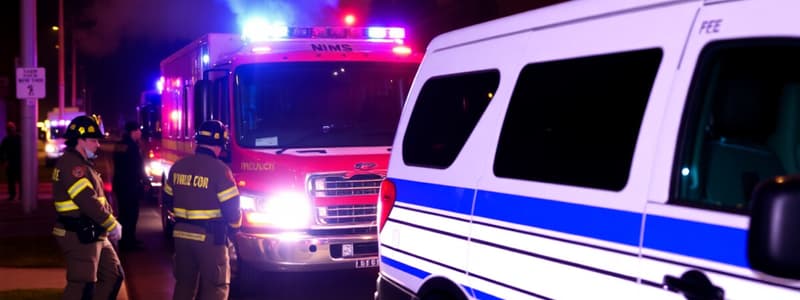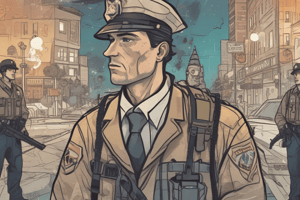Podcast
Questions and Answers
What is defined as a critical incident?
What is defined as a critical incident?
- An extraordinary event that endangers lives and property (correct)
- An emergency affecting only a single individual
- Any event requiring police presence
- A minor disturbance requiring minimal resources
Which component of the Incident Command System is responsible for assessing incident priorities?
Which component of the Incident Command System is responsible for assessing incident priorities?
- Incident Command (correct)
- Operations Section
- Planning Section
- Finance/Administration Section
What is the role of the Logistics Section in incident management?
What is the role of the Logistics Section in incident management?
- Managing tactical operations on-site
- Controlling the overall management of the incident
- Providing transportation and medical support (correct)
- Developing incident action plans
Which of the following best describes the purpose of the Regional Emergency Operations Center (REOC)?
Which of the following best describes the purpose of the Regional Emergency Operations Center (REOC)?
What does NIMS stand for?
What does NIMS stand for?
Which section is responsible for planning post-incident demobilization?
Which section is responsible for planning post-incident demobilization?
What is NOT a responsibility of the Finance/Administration Section?
What is NOT a responsibility of the Finance/Administration Section?
What kind of events does NIMS prepare for?
What kind of events does NIMS prepare for?
What is the primary goal of the termination phase in critical incident response?
What is the primary goal of the termination phase in critical incident response?
Which type of incident is NOT specifically listed as a critical incident in the response guide?
Which type of incident is NOT specifically listed as a critical incident in the response guide?
What action should the first police officer at the scene take?
What action should the first police officer at the scene take?
What is one of the SEVEN CRITICAL TASKS during the crisis response phase?
What is one of the SEVEN CRITICAL TASKS during the crisis response phase?
Who assumes command of the scene during the crisis response phase?
Who assumes command of the scene during the crisis response phase?
What should be established to keep officers and citizens safe during a critical incident?
What should be established to keep officers and citizens safe during a critical incident?
What is the role of the Fire Department OIC during hazardous materials incidents?
What is the role of the Fire Department OIC during hazardous materials incidents?
Which option best describes the sequence of actions for the first officer at the scene?
Which option best describes the sequence of actions for the first officer at the scene?
What is the primary role of police department personnel regarding transportation of injured persons at the triage area?
What is the primary role of police department personnel regarding transportation of injured persons at the triage area?
Which of the following is NOT a responsibility during the Scene Management Phase?
Which of the following is NOT a responsibility during the Scene Management Phase?
What is one of the first actions during the Executive Management Phase upon arrival of the ranking command officer?
What is one of the first actions during the Executive Management Phase upon arrival of the ranking command officer?
When establishing media and family briefing areas, where should they be located?
When establishing media and family briefing areas, where should they be located?
What is crucial to confirm before processing injured persons at the scene?
What is crucial to confirm before processing injured persons at the scene?
What should be done if conditions render the REOC inoperable?
What should be done if conditions render the REOC inoperable?
What is a key component of the initial response in an emergency situation according to the described procedures?
What is a key component of the initial response in an emergency situation according to the described procedures?
What action is recommended if there is a need to recall additional city personnel?
What action is recommended if there is a need to recall additional city personnel?
What should be done if an incident occurs near a hospital?
What should be done if an incident occurs near a hospital?
Who may be required to transport Medical Assistance Team Support?
Who may be required to transport Medical Assistance Team Support?
How should police officers on perimeter posts handle non-official vehicles transporting victims?
How should police officers on perimeter posts handle non-official vehicles transporting victims?
What determines the use of private vehicles for transporting injured persons?
What determines the use of private vehicles for transporting injured persons?
What is maintained by ECS and the field command post to manage casualties effectively?
What is maintained by ECS and the field command post to manage casualties effectively?
What is the first duty of supervisors upon arrival at the scene of an incident?
What is the first duty of supervisors upon arrival at the scene of an incident?
Which positions remain unchanged for all incidents in the NIMS Incident Command Chart?
Which positions remain unchanged for all incidents in the NIMS Incident Command Chart?
Which action must be taken to facilitate access for emergency vehicles?
Which action must be taken to facilitate access for emergency vehicles?
What action should the Special Events Unit take upon approval of a planned event?
What action should the Special Events Unit take upon approval of a planned event?
What score on the Regional Emergency Operations Center Activation Matrix prompts a recommendation for activation to the Police Chief?
What score on the Regional Emergency Operations Center Activation Matrix prompts a recommendation for activation to the Police Chief?
What should be done if there are fatalities at the incident site?
What should be done if there are fatalities at the incident site?
Which report is NOT listed among those that should be completed by the OIC during the incident?
Which report is NOT listed among those that should be completed by the OIC during the incident?
What task does the Emergency Communications Section NOT perform?
What task does the Emergency Communications Section NOT perform?
What is one of the responsibilities of district supervisors in relation to casualty care?
What is one of the responsibilities of district supervisors in relation to casualty care?
How should the perimeter be managed once control of the scene is established?
How should the perimeter be managed once control of the scene is established?
When preparing the Department After Action Report, what is the appropriate document used?
When preparing the Department After Action Report, what is the appropriate document used?
Flashcards are hidden until you start studying
Study Notes
Critical Incident Response Plan
- Critical Incident: An extraordinary event that requires numerous resources to resolve, due to imminent danger to life and property.
- National Incident Management System (NIMS): A nationwide template for government and private organizations to collaborate during incidents.
- Incident Command System (ICS): Component of NIMS providing a functional organizational chart for incident management.
- Incident Command: Controls overall incident management, prioritizes tasks, assesses resources, and coordinates with external agencies.
- Operations Section: Manages tactical actions at the scene, establishes control, minimizes hazards, ensures safety, and restores order.
- Planning Section: Prepares written action plans, gathers & distributes information, and plans incident closure.
- Logistics Section: Manages communications, transportation, medical support, supplies, and specialized team/equipment needs.
- Finance/Administration Section: Records personnel time, procures resources, tracks expenses, and manages injuries/liability.
- Regional Emergency Operations Center (REOC): Joint center serving Hamilton County and Cincinnati, coordinating planned events and emergencies.
Incident Response Procedures
- Initial Officer: Reports to Emergency Communications Section (ECS) about the incident, requests necessary equipment and personnel, and informs the district officer in charge (OIC).
- District OIC:
- Assumes command at the scene
- Implements seven critical tasks for incident resolution:
- Command and Control: Restricts radio channel, determines tactical channel/talk group, establishes the "kill zone" to restrict access, and designates perimeter locations
- Spontaneous Alert: Initiates Phase I if necessary
- Protection: Details officers to safeguard the area from looting.
- Triage Area: Established by Cincinnati Fire Department Incident Commander, where all injured individuals are processed.
- Public Information Office (PIO): A designated area for media briefings.
- Family Briefing Area: Established outside the perimeter for family members of victims.
- Executive Management Phase:
- Ranking command officer assumes command.
- Activates the REOC (or alternate site if REOC unavailable).
- Requests the Mobile Command Center (MCC) if necessary.
- Determines if a NIMS incident command system is needed.
- Briefs other department supervisors.
- Assigns specific areas to subordinate supervisors.
- Coordinates with other authorities for emergency vehicle access.
- Notifies Criminalistics Squad for evidence gathering and Hamilton County Coroner's Office in case of fatalities.
- Termination Phase/Incident De-escalation:
- Control established and disorder reduced, perimeter sizes are adjusted to minimize traffic disruption.
- OIC ensures completion of all reports generated during the incident.
- Emergency Communications Section (ECS):
- Notifies according to the situational occurrences list.
- Sets up or activates the Police Command Center (PCC) or the REOC.
- Contacts affected agencies and relays information.
- Advises on-scene personnel about expected agency responses.
- Maintains a log of radio transmissions.
- Casualty Care:
- District supervisors ensure smooth emergency vehicle flow to and from hospital emergency areas, identify emergency routes, and ensure appropriate police reports are filed.
- Police personnel may be needed to transport Medical Assistance Team Support (MATS), support personnel, equipment, and supplies.
- ECS and field command post maintain information about vehicle movements for efficient casualty handling and equipment reactivation.
- NIMS Incident Command Chart:
- Can be found on the H: Drive, Form NIMS/ICS.
- Only Incident Commander and four Section Chiefs remain constant across all incidents.
- Special Events Unit:
- Submits a completed Regional Emergency Operations Center Activation Matrix to Special Investigations Section/Intelligence Unit.
- If the matrix score reaches 30 or more, the Intelligence Unit recommends REOC activation to the Police Chief.
Studying That Suits You
Use AI to generate personalized quizzes and flashcards to suit your learning preferences.


